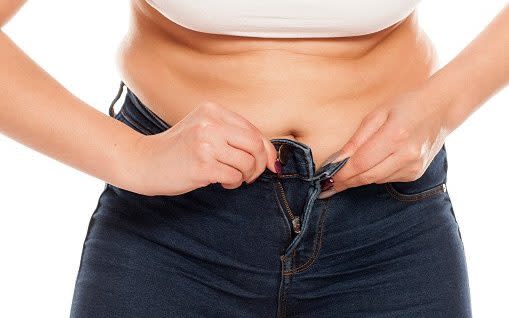How to get rid of dangerous belly fat

Covid-19 comes as a stark reminder of the extent to which being overweight is a threat to our health. Evidence shows that being obese doubles our risk of being hospitalised with the virus and new research from University College London found that people over 65 who are obese have a 31 per cent increased risk of dementia later in life.
Yet not all fat is created equal. We used to believe that body fat simply functioned as energy storage for the body, but we now know that different types of fat affect the body in different ways.
Excess fat around the middle is particularly harmful to our health as it can increase our risk of heart disease, type 2 diabetes, cancer and stroke.
Unlike subcutaneous fat, which lies beneath the skin, visceral fat sits under the abdominal wall surrounding vital organs like our liver, stomach and intestines. Excess visceral fat triggers low-level systemic inflammation, one of the main reasons why it’s linked to an increased risk of disease and faster ageing.
How do I know if I have too much visceral fat?
Your bathroom scales won’t be of much use here, since being in a healthy weight range for your height doesn’t necessarily mean you don’t have too much of it. Body mass index (BMI) has its limitations as an indicator of your weight’s impact on health.
Your BMI doesn’t take into account situations such as high muscle percentage, so the readings of professional rugby players and body builders can show them falling into the ‘obese’ category when they are anything but.
Many health experts now agree that our waist circumference is a more accurate indicator of health risk. Regardless of your height or BMI, it’s advisable to lose weight if your waist is greater than 94cm (37in) for men and 80cm (31.5in) for women.
You’re at very high risk of serious health issues as a man if your waist measurement is above 102cm (40in) or 88cm (34.5in) for women. You can take your waist measurement at home, simply using the tape measure in your sewing kit.
The cortisol connection
Elevated levels of the stress hormone cortisol are linked to increased fat storage around the middle. While we need some cortisol, when too much is produced (for example during periods of prolonged stress much as working long hours, moving house, divorce and so on) it disrupts other hormones that influence our weight and promotes fat storage.
Compared with subcutaneous fat, abdominal fat cells have four times more cortisol receptors, hence the stored fat is directed to our middle. And while many of our hormone levels decline as we age, sadly cortisol does not; it increases, which subsequently elevates our chances of gaining weight around the middle.
The good news is that there are steps you can take to effectively tackle it.
How to reduce visceral fat
De-stress
Stress reduction techniques, like a daily meditation practice, are known to reduce cortisol levels. There are many meditation apps available, including MEYA (welcometomeya.com) which uses sound wave therapy to relax you. Start with just 10 minutes a day at a time when you know you can be alone.
During momentary stress, such as at work, take a couple of moments to practise deep, slow breathing, counting in for four and out again for four. This acts to switch your nervous system from a sympathetic ‘fight or flight’ state to a parasympathetic ‘rest and digest’ state.
Drink less alcohol
Moderating alcohol intake is important – it’s called a ‘beer belly’ for a reason. Adaptogenic supplements – essentially anti-stressor plants – such as the Ayurvedic herb Ashwagandha, have also been shown to help lower cortisol levels.
Get enough sleep
Work on improving your sleep health. One study showed that adults under 40 who slept five hours or less a night had significantly more visceral fat after five years. If you’re not sure how many Zs you’re getting there are sleep tracking apps such as Sleepscore (sleepscore.com) to help you monitor.
Tweak your diet
Work to balance your blood sugar through structuring meals around a protein source (such as fish, seafood, eggs, tempeh or organic meat) with moderate amounts of healthy fats (such as olive oil, coconut oil, avocado, unroasted nuts and seeds) and a variety of vegetables and salad. Simultaneously aim to minimise your intake of sugar, starchy carbohydrates and highly processed foods.

Keeping a food diary for a week or two, noting down everything you eat, can be an enlightening experience and identify areas for improvement.
What doesn’t work: ab crunches
It can be tempting to focus on exercises that will tone our abdominals, but while these will strengthen muscles, endless sit ups alone won’t be enough to slim your waistline. Strengthening your core is important, but it will not significantly affect the fat in the area. Consistent exercise is important though, so find something you enjoy and can do it at least three times a week for 30 minutes. It’s worth noting that intense exercise can trigger cortisol, so strike a balance between getting your heart rate up, but not overdoing it.
Kim Pearson is a nutritionist and runs a weight loss clinic at https://www.kim-pearson.com/

